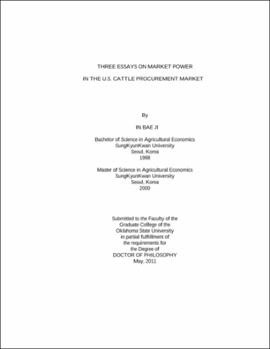| dc.contributor.advisor | Chung, Chanjin | |
| dc.contributor.author | Ji, In Bae | |
| dc.date.accessioned | 2013-11-26T08:22:01Z | |
| dc.date.available | 2013-11-26T08:22:01Z | |
| dc.date.issued | 2011-05 | |
| dc.identifier.uri | https://hdl.handle.net/11244/6517 | |
| dc.description.abstract | This study consists of three essays. The first essay tests the causality between captive supply and cash market price in the U.S. cattle procurement market. Three causality tests, the Granger test, the Sims test, and the Modified Wald test, were conducted for four relationships: cash market price-total captive supply, cash market price-marketing agreement, cash market price-forward contract, and cash market price-packer fed cattle. All three tests indicate that cash market price is caused by total captive supply and marketing agreement. The Modified Wald test shows the bidirectional causality between cash market price and forward contract. Also, the Modified Wald test finds no causal relationship between cash market price and packer fed cattle. Overall test results indicate that captive supply causes cash market price, and the results favor the price dependent model over the quantity dependent model. | |
| dc.description.abstract | The second essay measures the impacts of concentration and captive supply on oligopoly and oligopsony market power and cost efficiency in the U.S. beef packing industry using both static and dynamic empirical industrial organization models. Two separate sources of oligopsony power are considered: the cash cattle procurement market and the captive supply market. The results show the presence of market powers in both beef retail and cattle procurement markets. The oligopsony market power is greater but more unstable than oligopoly market power throughout the entire sample period. Concentration and captive supply play a role in increasing market power. The cost efficiency effects caused by increasing concentration and captive supply outweigh the market power effects. | |
| dc.description.abstract | The third essay uses the new empirical industrial organization approach with the Bertrand model to measure the oligopsony market power in the U.S. cattle procurement market. It tests whether the market power is caused by concentration, cattle cycle, and seasonality. The results show that the oligopsony market power exists in the U.S. cattle procurement market. The cattle cycle and seasonality affect the oligopsony market power and the cattle cycle causes the change in market power. However, concentration has a negative effect on the oligopsony market power. | |
| dc.format | application/pdf | |
| dc.language | en_US | |
| dc.rights | Copyright is held by the author who has granted the Oklahoma State University Library the non-exclusive right to share this material in its institutional repository. Contact Digital Library Services at lib-dls@okstate.edu or 405-744-9161 for the permission policy on the use, reproduction or distribution of this material. | |
| dc.title | Three essays on market power in the U.S. cattle procurement market | |
| dc.contributor.committeeMember | Peel, Derrell S. | |
| dc.contributor.committeeMember | Raper, Kellie Curry | |
| dc.contributor.committeeMember | Currier, Kevin M. | |
| osu.filename | JI_okstate_0664D_11419 | |
| osu.accesstype | Open Access | |
| dc.type.genre | Dissertation | |
| dc.type.material | Text | |
| dc.subject.keywords | captive supply | |
| dc.subject.keywords | cattle market | |
| dc.subject.keywords | causality | |
| dc.subject.keywords | concentration | |
| dc.subject.keywords | market power | |
| dc.subject.keywords | neio | |
| thesis.degree.discipline | Agricultural Economics | |
| thesis.degree.grantor | Oklahoma State University | |
